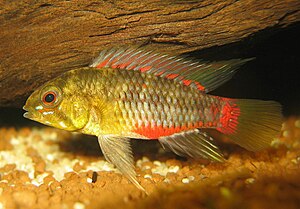Red line apistogramma
| Red line apistogramma | ||||||||||||
|---|---|---|---|---|---|---|---|---|---|---|---|---|

Red line apistogramma ( Apistogramma hongsloi ) |
||||||||||||
| Systematics | ||||||||||||
|
||||||||||||
| Scientific name | ||||||||||||
| Apistogramma hongsloi | ||||||||||||
| Kullander , 1979 |
The red line apistogramma ( Apistogramma hongsloi ) is a species from the cichlid family . It is one of the species that are now often kept in aquariums.
Appearance
Males of the red line apistogramma reach a body length of up to seven centimeters. Females stay significantly smaller and reach a body length of up to four and a half centimeters when fully grown. The body of the fish is moderately high back. The caudal fin is rounded. In the male, there is also a strongly extended anal and dorsal fin. The color of the species is very variable, although it is still to be clarified whether it is geographical variants or races. A blue-yellow breed is known in which the ventral fin of the males is a strong lemon yellow, but most of the body is a bright light blue. In contrast, the males occurring in the Rio Cataniapo have a beige base tone and are much more simply colored.
The females generally have a yellow basic color. During breeding, females have a more intensely colored breeding dress.
Distribution area
Compared to other types of Apistogramma , the red line Apistograma occur in a relatively large area of distribution. They can be found in the catchment area of the upper and middle Orinoco in Colombia and Venezuela .
In this distribution area, the fish are only found in the flat and low-current peripheral areas. They hide from predators in the dense stands of aquatic plants.
Reproduction
Rotstrich-Apistogramma are cave breeders . The females lay the clutch under roots and similar hiding places. The brood care is done by the females alone.
In the aquarium
Rotstrich-Apistogramma are considered to be a robust and adaptable species. However, they thrive best in aquariums with soft water and a pH value in the acidic range, as this corresponds to their natural living conditions. It is also important for them that the aquarium is densely planted, as the fish like to hide in the dense vegetation. The aquarium should have a minimum length of 100 centimeters and hold 150 liters. They can be socialized with tetras and quiet cichlids .
Individual evidence
- ^ Wally Kahl / Burkard Kahl / Dieter Vogt, Kosmos Atlas Aquarienfische, page 214, Franckh-Kosmos Verlags-GmbH & Co Stuttgart 2003
literature
- Horst Linke, Wolfgang Staeck: Small cichlids - A manual for determination, care and breeding , Tetra Verlag, Bissendorf 2001, ISBN 3-89745-100-X
